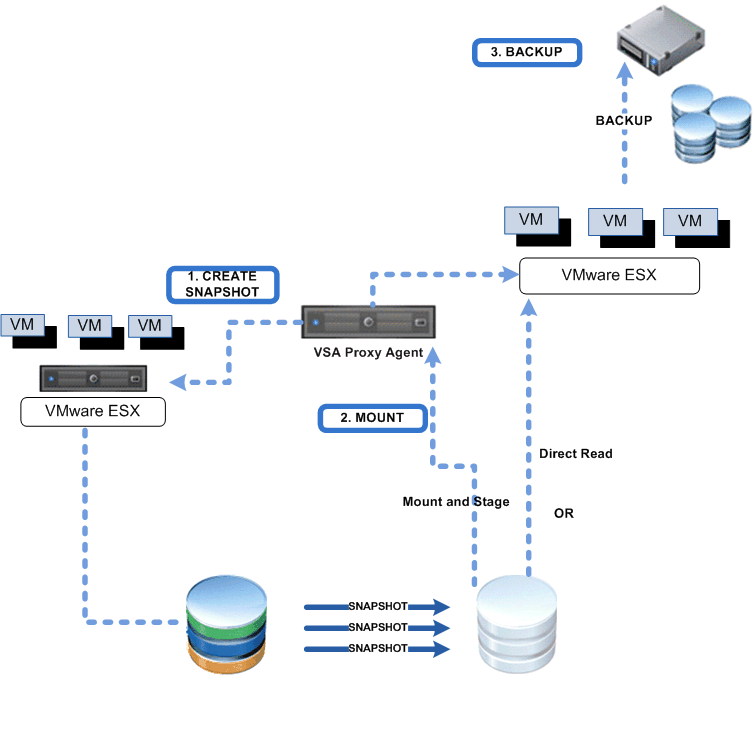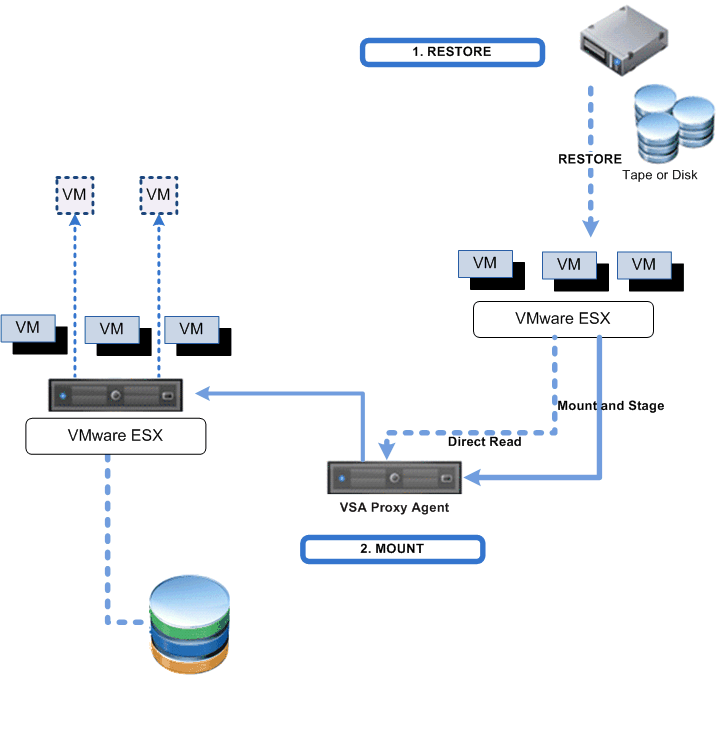Data Protection and Recovery with VCB and vSphere VADP
Overview
Data Protection with vSphere
VADP
Data
Protection with vSphere VADP and VCB Combinations
Data Protection with VCB
Enabling vSphere VADP Support
Considerations for vSphere VADP Environments
The Virtual Server iDataAgent
seamlessly integrates with VMware's built-in VMware Consolidated Backup (VCB)
and vSphere vStorage API for Data Protection (VADP) technologies. While the
backup and restore process itself remains the same in either environment, the
resources and operational time varies based on the technology used. The
following sections describe how your backup and restore operations function in
environments with each technology.
With the advent of the vSphere 4.x architecture, backup and restores can be
performed using the vStorage API for Data Protection. This new API set provides
significant performance improvements over VCB, including the following:
-
 During backups, virtual machine data is not copied to a proxy server prior
to moving to the storage media. Rather, the Virtual Server
iDataAgent creates a snapshot of
the virtual machine data directly from the datastore itself. The snapshot is
then moved directly to the storage media without requiring any dedicated disk
cache on the proxy server. This capability significantly improves backup speed,
alleviates large amounts of resources on the proxy server, and allows for many
more virtual machines to be backed up simultaneously. During backups, virtual machine data is not copied to a proxy server prior
to moving to the storage media. Rather, the Virtual Server
iDataAgent creates a snapshot of
the virtual machine data directly from the datastore itself. The snapshot is
then moved directly to the storage media without requiring any dedicated disk
cache on the proxy server. This capability significantly improves backup speed,
alleviates large amounts of resources on the proxy server, and allows for many
more virtual machines to be backed up simultaneously.
- Incremental backups are enhanced with Change Block Tracking (CBT), which
quickly identifies only the data blocks on the virtual machine that have changed
since the last backup. This replaces the need for the Virtual Server
iDataAgent to scan the entire virtual
machine with complex checksum calculations to determine what data has changed,
which results in faster backup time.
|
-
 Virtual machines are restored directly to the appropriate ESX Server and
datastore without the need for staging on the proxy server with VMware Converter.
This capability provides for much faster restores. Virtual machines are restored directly to the appropriate ESX Server and
datastore without the need for staging on the proxy server with VMware Converter.
This capability provides for much faster restores.
|
Overall, data protection and recovery in vSphere VADP environments is
significantly faster and resource efficient than VCB environments. As such, it
is recommended that data protection and recovery be performed with vSphere VADP
whenever possible.
Requirements
To protect data in a vSphere VADP environment, the following requirements
must be met:
- Specific Virtual Server iDataAgent
software updates must be installed on the server hosting the Virtual Server
iDataAgent for vSphere VADP. Contact your software
provider to obtain these updates.
- The
VStorageEnable registry key must be created to enable vSphere
VADP support.
- The appropriate supported VMware software must be installed as described
in System
Requirements - Virtual Server iDataAgent.
The
Virtual Server iDataAgent not only
provides the ability to protect and recover data in VCB and vSphere-specific
environments individually, but also environments wherein both technologies
exist. To accomplish this, the proxy computer requires the following:
- The Virtual Server iDataAgent,
including the appropriate software updates. Contact your software
provider to obtain these updates.
- The appropriate supported VMware Consolidated Backup (VCB) (See
System
Requirements - Virtual Server iDataAgent
for supported versions.)
Once these components are configured, backup and restore operations will
leverage between VCB and vSphere VADP as necessary.
For ESX Servers prior to version 4.x, protection and recovery of virtual machine
data requires a proxy server to be used as a landing area for the data to
be processed before being backed up or restored. In addition to ample disk space
for copying the virtual machine data, the proxy server also requires the Virtual
Server iDataAgent, VMware
Consolidated Backup, and VMware Converter to be installed to process all the
data prior to moving to the backup media or restore destination.
For backups at the disk level, VCB must first create a snapshot of the
virtual machine and copy the blocks associated with the snapshot to the proxy
server. The Virtual Server iDataAgent
must then direct the data to the appropriate backup media. Similarly, for
volume-level backups, VCB must create a snapshot of the virtual machine and
subsequently mount the NTFS file system on the proxy server before being backed
up to the appropriate backup media. Subsequent
restores require the VMware Converter utility to stage the data before being
reintroduced to the destination ESX Server.
Requirements
To protect data in a VCB environment, the following requirements must be met:
- The Virtual Server iDataAgent
must be installed.
- A sufficient amount of disc cache must be available for the Job Results
folder to properly process the virtual machine data.
- If the Virtual machine version is 4.0, backups will be failed back to
VCB mounter and backup continues. Hence, it is recommended to upgrade your
virtual machines to v7.0.
- The appropriate supported VMware Consolidated Backup (VCB) and VMware Converter
software must be installed. (See
System
Requirements - Virtual Server iDataAgent
for supported versions of these utilities.)
Support for vSphere VADP data protection and recovery can be enabled by
performing the following steps:
-
Ensure the Calypso Service Pack 4
software is installed on the server hosting the Virtual Server iDataAgent.
-
- Download the following software components:
- Service Pack 4 March 2010 Update Pack
- VMware vStorage VDDK
- Apply both the Service Pack 4 March 2010 Update Pack and VMware vStorage
VDDK components to the server hosting the Virtual Server iDataAgent.
If installing VDDK on 64-bit operating systems, the
following steps must be performed:
- VDDK 1.1.1 must first be installed on the proxy
server to its default location.
For example, C:\Program Files
(x86)\VMware\VMware Virtual Disk Development Kit
- Create a new, similar path on the proxy computer.
For example,
C:\Program Files\VMware\VMware Virtual Disk
Development Kit\
- Unzip the vddk64 folder to a
temporary location. Once unzipped, copy the
bin, lib, and
plugins folders to the original
install location created in Step 2. If prompted to
overwrite the existing files and folders, select Yes.
- Create the following registry key:
HKEY_LOCAL_MACHINE\SOFTWARE\VMware, Inc.\VMware Virtual Disk
Development Kit\InstallPath
with the following value:
C:\Program Files\VMware\VMware Virtual
Disk Development Kit\
- Finally, enable the
VStorageEnable registry key with the value set to
1.
Once the above steps are complete, you are able to perform backups and
restores in vSphere VADP environments.
Consider the following for vSphere VADP environments:
- If a virtual machine has been cloned or migrated from another ESX
Server, ensure the virtual machine is rebooted prior to running your first
backup.
- Stand-alone ESXi is not supported without the standard license level.
- Virtual machines configured as vAPP are not supported.
|
- vSphere VADP File-level backups do not support filtering by individual
Drives. You can replace the drive letter by an asterisk '*'.
For Example:
[C:\**\Windows*\**] -> [*:\**\Windows*\**]
[C:\**\Program Files*\**] -> [*:\**\Program Files*\**]
Note that, providing an '*' will filter out the selected folders
and files from all drives.
- vSphere VADP Volume level backups does not support global
filters.
- If the Virtual machine version is of v4.0, backups will be
failed back to VCB mounter and backup continues. Hence, it is
recommended to upgrade your virtual machines to v7.0.
|
Troubleshooting
Backup jobs may fail during Createsnapshot task
due to (ESX IO frozen error)
Solution: Reinstall VMware tools on the virtual machine and rerun the
backup.
Virtual machines may fail to back up due to a
failure in downloading the .vmx
configuration file
Solution: Ensure the vCenter credentials are also valid on the ESX
Server. Users on both vCenter and ESX Server should have minimum privileges for
backup and restore operations.
Back to Top
 During backups, virtual machine data is not copied to a proxy server prior
to moving to the storage media. Rather, the Virtual Server
iDataAgent creates a snapshot of
the virtual machine data directly from the datastore itself. The snapshot is
then moved directly to the storage media without requiring any dedicated disk
cache on the proxy server. This capability significantly improves backup speed,
alleviates large amounts of resources on the proxy server, and allows for many
more virtual machines to be backed up simultaneously.
During backups, virtual machine data is not copied to a proxy server prior
to moving to the storage media. Rather, the Virtual Server
iDataAgent creates a snapshot of
the virtual machine data directly from the datastore itself. The snapshot is
then moved directly to the storage media without requiring any dedicated disk
cache on the proxy server. This capability significantly improves backup speed,
alleviates large amounts of resources on the proxy server, and allows for many
more virtual machines to be backed up simultaneously.